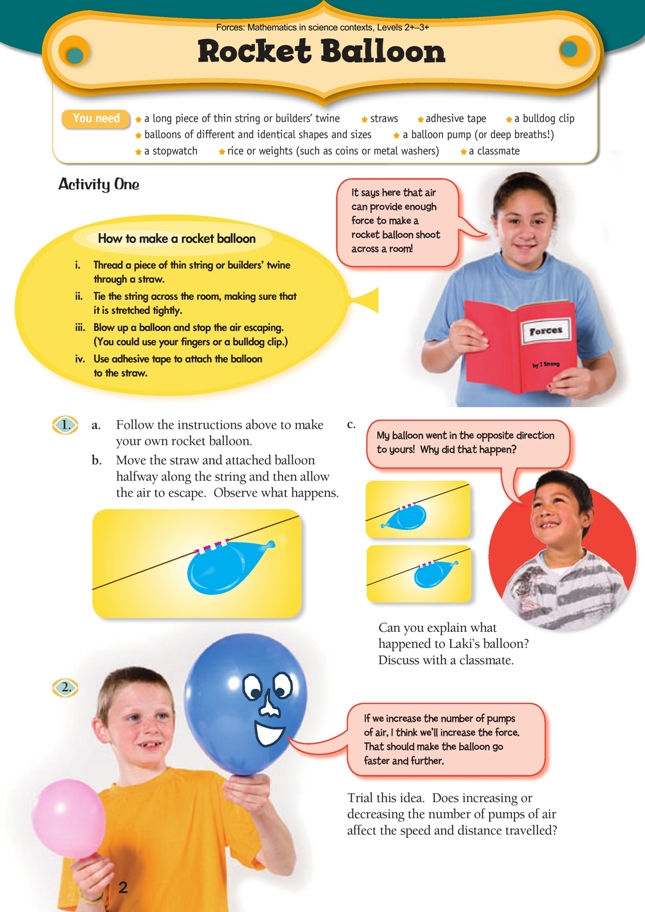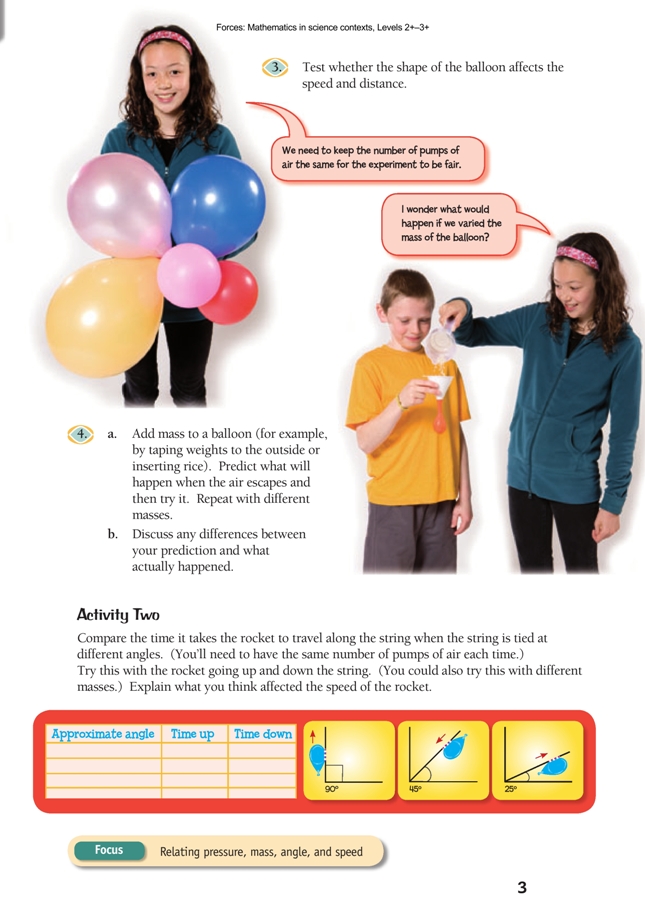This is a level (2+ to 3+) mathematics in science contexts activity from the Figure It Out series.
A PDF of the student activity is included.
Click on the image to enlarge it. Click again to close. Download PDF (834 KB)
Students will:
- measure mass, angle, time, and pressure
- record data in tables
- find the function relationships between pressure, mass, distance, time, and angle for a rocket balloon.
Students should discover that:
- force is proportional to mass (you need a bigger force to push a bigger mass the same distance)
- the relative magnitude of the force of gravity depends on the angle at which it’s being measured, (for example, the acceleration of gravity is constant yet exerts no force in a direction parallel to the ground)
- the balloon’s jet force is a function of pressure (how much air you put in the balloon).
a balloon pump (or deep breaths!)
balloons of different and identical shapes and sizes
a stopwatch
rice or weights (such as coins or metal washers)
adhesive tape
straws
a long piece of thin string or builders' twine
a classmate
FIO, Forces, Levels 2+-3+, Rocket Balloon, pages 2 - 3
Activity One
Preparation and points to note
Make sure that there is enough uninterrupted space for the strings to stretch across the room without crossing.
Plan some initial exploration to help the students identify which direction the balloon will travel when the air is released. They will also need to practise co-ordinating their timing with the release of the balloon. For example, one student could hold the balloon closed until the person starting the stopwatch calls out “go”. Using a set length of string with a designated end mark makes timing easier: one student could watch the end and shout “stop” as the balloon crosses the mark. Note: By keeping the distance constant and measuring the time, the students are effectively measuring the speed.
The string needs to be long enough for meaningful timing to be possible but not so long that carrying extra mass* requires so much air pressure that the balloon is close to popping.
The friction effect of the string is important. The balloons will travel a long distance on fi shing line, so the difference between 1 pump of air and 2 pumps will be more obvious. Rough twine will stop the balloon in a shorter distance, making measurement error more significant.
Make sure the students understand that the balloon rocket does not stop because it “ran out of air”. Newton’s first law states that an object in motion will tend to remain in motion unless acted upon by an outside force. In theory, a balloon rocket on a perfectly horizontal string will keep going no matter how little air you pump into it. The balloon stops because the friction of the line (or gravity, if at an angle) is acting against the motion.
Encourage the students to discuss their results. This will reinforce the key competency thinking by providing opportunities for students to learn from their mistakes, improve their processes, and refi ne their conclusions.
Points of entry: Mathematics
Scale is very important: 1 big pump of air is different from 2 little pumps. Prompt the students to think about how they can accurately measure and record inputs (how many pumps) and outputs (how far or how fast it went). Encourage them to use consistent units of their own devising. They could develop informal units or use this opportunity to learn or practise reading a scale for measuring the distance travelled along the string.
Introduce the idea of function (the same input should always yield the same output). In other words, 3 pumps of air should cause the balloon to travel about the same distance every time.
See if the students can define rules for the relationships they observe, for example, How does the number of pumps relate to distance? The students may be able to find a proportion or factor that enables them to predict distance in terms of pumps. Ask them to investigate how mass changes the relationships.
Points of entry: Science
Probe your students’ knowledge of the scientifi c inquiry method (see page 5). Frame the investigation using scientific language: What makes a trial a fair trial? Use opportunities to introduce or reinforce vocabulary such as hypothesis, prediction, mass, and force.
Make sure that the students discuss why their predictions were accurate or inaccurate and that they generalise their results. Ask What does your experiment teach you about the physical world?
Note that if the same balloon is used for repeated trials, the elasticity of the balloon decreases with each inflation, which may affect the results. This is a good opportunity to discuss the acceptability of experimental error. An alternative is to use a new, identical balloon for each trial, but the problem then is that it will be difficult to attach the straw in exactly the same position so that the balloon lines up at the same angle. Again, this is an experimental error issue and may affect the results more than using the same balloon.
Answers
Activity One
1. a.–b. Practical activity. Results and observations will vary. (As long as the straw can move freely along the string, the balloon will shoot across the room. The air trapped inside the rocket balloon is under greater pressure than the air outside [that’s why the balloon “blows up”]. When this pressurised air is allowed to escape, it rushes out of the balloon. [Newton’s third law states that to every action there is an equal and opposite reaction. The balloon moves in the opposite direction to the escaping air.] The rocket balloon works the same way as you would if you were standing on a skateboard holding a heavy backpack. If you throw the backpack one way, you roll the other way. In this case, instead of a backpack, the rocket balloon “throws” air one way and jets off the other way.)
c. The balloon always moves in the opposite direction from the jet of air.
2. The more compressed air there is in the balloon, the more force it will have and the faster it will move. If you decrease the number of pumps (lower the air pressure), the balloon has less force and will go slower.
3. Results will vary. Shape probably doesn’t make much difference, although some shapes will need
more air to fi ll up and other shapes will release the air faster (more force!). A large balloon will be affected by the air and wind more than a long skinny balloon, but in a classroom, the amount of air you put in each balloon is probably more important than air resistance.
4. a.–b. Practical activity. Predictions and results will vary. With the added mass, it will require more force to move the balloon, so you’ll need to pump more air into it to move it at the same speed as before. The more mass you add, the harder it will be to get the balloon moving. If you put too much mass on the balloon, the force generated by the air escaping from the balloon won’t be enough to move the combined mass of the balloon and weights.
Activity Two
Preparation and points to note
Consider using protractors or prepared cut-outs of different angles to simplify finding angles.
Depending on the length of the string, it may not be possible to reach a 45º angle. Either substitute a
shallower angle or adjust the length of the string.
Students should run several trials of each configuration because there may be a lot of measurement error in the timing, especially when the rocket is moving with gravity. Set expectations about what makes a valid trial and emphasise the importance of repeatable results.
Points of entry: Mathematics
The students should develop and interpret tables and graphs to identify patterns. They could do this using a spreadsheet. Stress that they need to capture enough information in their tables to distinguish what they are testing in each trial. Encourage them to only change one variable at a time, for example, if they are increasing the mass, they should keep the angle the same to see the effect of increased mass on the time taken. Prompt the students to discuss why they should change only one variable at a time.
As part of exploring units, the students should discuss how they measure different aspects of the experiment, for example, using protractors to measure angles or using a stopwatch to measure seconds.
While accuracy is a goal, the identification of patterns or relationships is more important. Outliers can be the focus of useful discussion and may indicate that the students need to examine the way a result was obtained.
At this level, you need only elicit definitions in the students’ language for how the force of gravity changes with angle. For example, at a shallow angle, there is only a small portion of gravity changing the motion, but at a steep angle, gravity has a bigger effect. Continue the exploration of functions and proportional relationships.
Make sure the students are aware of experimental error and how it can be minimised. You may want to get several groups to run the same trials and combine their data. Ask the students to work out the best way to combine the results of separate trials. Ask What if more groups have tested 60º than 45º: can the different number of trials be combined the same way?
Introduce the idea that force has a direction as well as a magnitude.
Depending on how fast the rockets travel, it might be necessary to discuss precision and accuracy. For example, What if the rocket goes so fast that we can’t click the stopwatch on and off quickly enough to time it accurately?
Points of entry: Science
Reinforce use of the scientific inquiry method (see page 5). Ask the students to think about which trials they might have to throw out or repeat.
Discussion should focus on issues of fairness: Same balloon? Same type of balloon? Same number of pumps of air? Same distance travelled? Same lengths of straw? Same type of string?
In this activity, there may be three distinct motions: initial acceleration, a period of constant speed, and deceleration (slowing down). It’s important that the students realise that a force causes a mass to accelerate. You could emphasise this by having students use straws to blow marbles across a desktop.
Reflective discussion could focus on other real-life applications, for example, doing work against gravity such as walking up a steep hill or rock climbing and the increasing effect of gravity as the angle becomes steeper.
Confront the students with the idea that there are many forces acting on the balloon at the same time and that these forces are stronger or weaker depending on the number of pumps of air and the angle. Advanced students can try to make freehand diagrams showing all the forces.
Ask What further investigations might we do? Prompt the students to develop additional hypotheses and test them.
Answers
Activity Two
Investigation results will vary. When the string is horizontal (0º), the balloon speed is not affected
by gravity because it’s not moving up or down. As you change the angle, the balloon will start to go much faster down the string than up. Going up, the balloon has to fi ght gravity, but when it’s going
down, gravity gives it a boost. The higher the angle, the faster it goes down and the slower it goes up
because more of the force is in the same direction as gravity.

